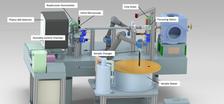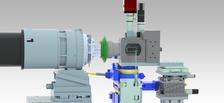Figure 1: HiPhaX experimental hutch overview. The instrument offers a high degree of automation including automatic sample exchange for both measurements at cryogenic and also at non-cryogenic temperatures between 0°C and 60°C and with adjustable relative humidity.
DESY’s new instrument HiPhaX is dedicated to ‘High-throughput Pharmaceutical X-ray screening’ for the early stage of drug development. The goal of HiPhaX is to provide a highly reliable instrument with the highest degree of automation possible to both academic and industrial users. In its final state HiphaX will allow fully automatic and unattended data collection with a throughput of more than 1000 samples in 24 hours. An overview of the HiPhaX experimental hutch and its installations is provided in figure 1.
HiPhaX operates at a fixed X-ray energy of 16 keV and an X-ray spot size of 15 - 20 um at the sample position. The beamline is equipped with a high-precision Roadrunner goniometer allowing for both conventional single-crystal rotation data collection as well as high-speed fixed target serial crystallography experiments (figure 2).
A special emphasis on HiPhaX lies on experiments at non-cryogenic temperatures in a humidity-controlled atmosphere. For this the instrument is equipped with a specially designed measurement chamber with allows adjusting the relative humidity between 30 – 100% r.h. and at the same varying the measurement temperature between 0° C and 60 °C. Such data collections at non-cryogenic temperatures are ideally performed in a serial fashion by collecting diffraction data from a large number of crystals. By overcoming the radiation dose limitations from conventional single crystal rotation data collection, serial data collection allows reaching almost the same resolution as accessible with data collection at cryogenic temperatures.
For efficient serial data collection crystals are presented on so-called ‘fixed-target’ sample holders to the X-ray beam. Different designs and sizes of these sample holders are available and will be provided for free to the instrument users. An overview of the different available fixed-target sample holders is provided in figure 3. For screening applications, we recommend the usage of compartmented chips, which provide space for up to 12 different compounds on a single chip. Crystals can be either directly grown on the chips or applied as a crystal-suspension. Compounds can be either applied to pre-grown crystals by soaking or by co-crystallization. For efficient automated fixed-target serial data collection, the instrument is equipped with a chip storage hotel with capacity for 10 large Roadrunner II chips and a robotic arm for fully automated chip exchange.
In addition to pure screening applications the setup at HiPhaX allows to systematically explore the influence of relative humidity and temperature on protein structures and to explore their conformational flexibility. In many cases this knowledge is valuable additional information leading to a higher success rate for computational ligand binding predictions.
For experiments at cryogenic temperatures the instrument is equipped with a large LN2 storage Dewar with a capacity for 868 samples mounted on uni-pucks. The sample changer is equipped with a novel magnetic sample gripper providing extremely high reliability as it does not involve any mechanically moving parts. Samples exchange times are below 20 seconds. The instrument further offers automatic loop-centering and subsequent automatic X-ray centering of the crystals in the beam.
During the measurements the beamline provides real-time feedback about hit rates and auto-processing of the diffraction data. In future we will further offer automatic structure refinement and hit identification.
HiPhaX is supported and receives funding through BMBF projects XDD () and SFX2.0 (05K19GU4) and Helmholtz projects HiACTS and HIR3X.
For questions and inquiries please contact Pontus Fischer (pontus.fischer@desy.de) or Alke Meents (alke.meents@desy.de).







